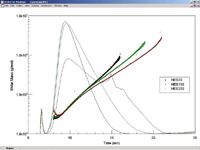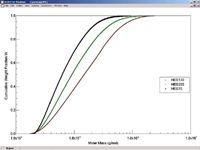Hydroxyethylstarches (HES)
Hydroxyethylstarches (HES) are used increasingly as plasma expanders in medical applications.
Wyatt Technology Corporation
Hydroxyethylstarches (HES) are used increasingly as plasma expanders in medical applications. The HES' circulation time in the blood depends strongly on its molar mass distributions. Historically, polysaccharide characterization by gel permeation chromatography (GPC) has been problematic, especially if high molar mass components are present. Due to its superior separation capability, especially on molecules exceeding 50 kDa, flow field-flow fractionation (Flow-FFF) is an excellent separation alternative. By coupling this technology to a multi angle light scattering (MALS) detector, such as a DAWN or miniDAWN, absolute values can be determined without making any assumptions.
We characterized 0.2% (w/v) HES solutions in doubly-distilled water. The HES types were 200/0.5, 130/0.42, and 70/0.5 from Serumwerk Bernburg, Germany. The FFF system was an Eclipse connected to a DAWN EOS and an RI detector (Shodex 101). Volumes of 100 μL were injected into the 350 μm spacer channel containing a 10 kDa regenerated cellulose membrane. A channel flow of 1 mL/min was kept constant while the cross flow decreased linearly from 2 mL/min to 0 mL/min within 20 min. Data were evaluated using Wyatt's ASTRA software package.

Figure 1: The fractograms of the three samples with their molar mass values overlaid.
The aF-FFF/MALS fractograms of the HES types are compared in Figure 1. Corresponding to normal mode Flow-FFF theory, samples with smaller average molar mass elute faster. In Figure 2, the molar mass distributions are given as cumulative weight fraction plots. As is evident in the plots, monomodal distributions were successfully achieved. The values covered a range from approximately 20 kDa to approximately 600 kDa and up to 2 GDa in size, depending on the characterized HES type. Thus, the average molar mass value was mainly influenced by high molar mass fractions. This was also indicated by higher polydispersity values for HES types with higher molar mass.

Figure 2: Three different HES samples shown on the cumulative weight fraction plot of ASTRA, indicating the large differences among them.
Asymmetrical FFF/MALS is, therefore, an excellent method for characterizing medical polysaccharides such as HES. The main advantage of this technique is that molar mass distributions can be determined from absolute values over an extremely wide range of masses.
This note graciously submitted by C. Augsten, K. Mäder, Institute of Pharmaceutics and Biopharmaceutics of the University Halle, W.-Langenbeck-Str. 4, 06120 Halle/Saale, Germany.
DAWN®, miniDAWN®, ASTRA®, Optilab®, and the Wyatt Technology logo are registered trademarks of Wyatt Technology Corporation.

Wyatt Technology Corporation
6300 Hollister Avenue, Santa Barbara, CA 93117
tel. (805) 681-9009; fax (805) 681-0123
Website: www.wyatt.com

SEC-MALS of Antibody Therapeutics—A Robust Method for In-Depth Sample Characterization
June 1st 2022Monoclonal antibodies (mAbs) are effective therapeutics for cancers, auto-immune diseases, viral infections, and other diseases. Recent developments in antibody therapeutics aim to add more specific binding regions (bi- and multi-specificity) to increase their effectiveness and/or to downsize the molecule to the specific binding regions (for example, scFv or Fab fragment) to achieve better penetration of the tissue. As the molecule gets more complex, the possible high and low molecular weight (H/LMW) impurities become more complex, too. In order to accurately analyze the various species, more advanced detection than ultraviolet (UV) is required to characterize a mAb sample.















